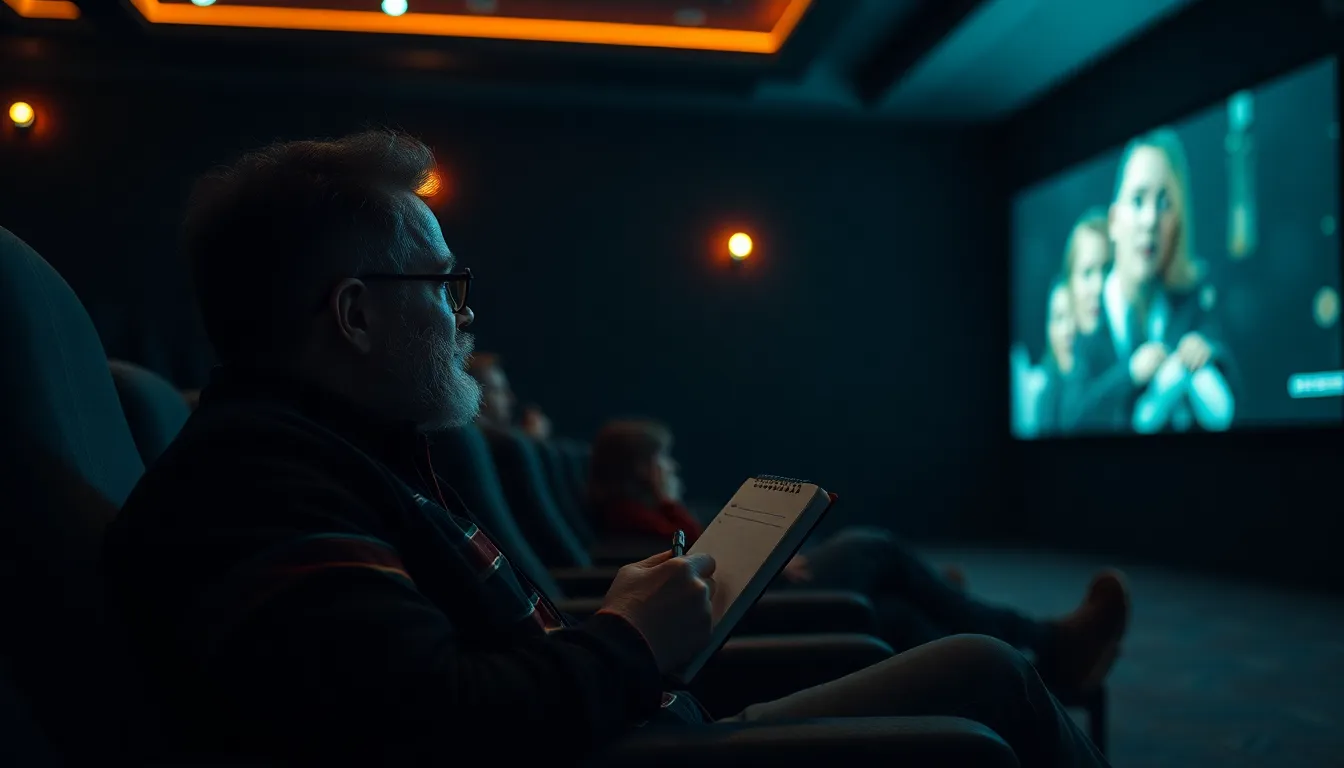Film critiques play a vital role in shaping the cinematic landscape. They offer insights that go beyond mere plot summaries, diving deep into themes, performances, and the artistry behind the camera. Whether it’s a blockbuster or an indie gem, critiques help audiences navigate the vast sea of films available today.
In an era where streaming services flood viewers with options, understanding the nuances of film critiques can enhance one’s viewing experience. Critics analyze everything from direction and cinematography to sound design and acting, providing a comprehensive view that can elevate appreciation for the medium. By exploring the world of film critiques, audiences can discover not just what to watch, but why certain films resonate on a deeper level.
Table of Contents
ToggleUnderstanding Film Critiques
Film critiques play a crucial role in the cinematic experience, offering audiences valuable insights into various aspects of filmmaking. They assist viewers in making informed choices in an era dominated by streaming platforms.
Importance of Film Critiques
Film critiques guide audiences by analyzing essential elements such as storytelling, character development, and visual aesthetics. They foster appreciation for the art form, encouraging deeper engagement with themes and performances. Critiques also provide a platform for diverse voices, highlighting underrepresented filmmakers and stories. Their insights stimulate thoughtful discussions, enhancing cultural conversations around films.
Different Types of Film Critiques
Film critiques come in several formats, each serving its unique purpose:
- Professional Critiques: Published by film critics, these reviews analyze technical aspects and contextual relevance, offering informed assessments.
- Audience Reviews: Non-professional critiques on platforms like Rotten Tomatoes or IMDb reflect general audience opinions and experiences.
- Academic Critiques: Scholarly papers and analyses dissect films through theoretical frameworks, exploring cultural, historical, or philosophical themes.
- Video Essays: Online video critiques blend visual storytelling with analysis, engaging viewers through dynamic presentation of film concepts.
- Podcast Reviews: Audio critiques provide informal discussions, allowing for in-depth exploration of films while reaching auditory learners.
Each type of critique contributes to the broader understanding of cinema, fostering a vibrant dialogue within the film community.
Key Elements of a Film Critique

Film critiques analyze several essential elements, enhancing audience engagement and understanding of cinematic works. Two key components in the critique process are narrative analysis and cinematographic techniques.
Narrative Analysis
Narrative analysis focuses on evaluating the structure and content of the story. It examines plot development, pacing, and the coherence of the narrative arc. Through this lens, critics assess character motivations and challenges, identifying how they contribute to overall themes. Critics often explore subtext and symbolism, revealing deeper meanings within the story. Effective narrative analysis illuminates the emotional impact of films, helping audiences connect with characters and their journeys.
Cinematographic Techniques
Cinematographic techniques shape the visual storytelling of a film. Critics analyze aspects such as shot composition, camera movement, lighting, and color palettes. These elements create mood and atmosphere, influencing how viewers perceive the narrative. Critics evaluate how effective the cinematography enhances or detracts from the storytelling. By examining these techniques, critiques reveal the artistry behind visual choices, emphasizing their role in evoking emotions and guiding viewer responses.
Influential Film Critics
Influential film critics shape the discourse around cinema, offering insights that resonate with audiences and filmmakers alike. They bridge the gap between creation and consumption, enhancing the cinematic experience through their analysis.
Historical Figures
Historical figures in film criticism laid the foundation for modern critiques. Notable critics include:
- Andrew Sarris: Introduced the auteur theory, emphasizing the director’s role in shaping a film’s artistic vision.
- Pauline Kael: Heralded for her passionate and personal writing style, Kael engaged readers with her deep analyses and cultural insights.
- Roger Ebert: Renowned for making film criticism accessible, Ebert’s reviews reached wide audiences, blending humor and intellect.
- François Truffaut: As both a critic and filmmaker, Truffaut highlighted the importance of personal expression in cinema, bridging theory and practice.
These figures influenced generations of critics and filmmakers, establishing standards for film evaluation and appreciation.
Contemporary Voices
Contemporary voices in film criticism continue to evolve the landscape, reflecting diverse perspectives. Prominent critics include:
- A.O. Scott: Known for his incisive critiques in The New York Times, Scott blends literary analysis with cinematic insight.
- Odie Henderson: A contributing critic at RogerEbert.com, Henderson explores the intersection of film and culture through a contemporary lens.
- Alissa Wilkinson: Writing for Vox, Wilkinson focuses on how films relate to broader cultural conversations, engaging audiences with relevant themes.
- Christy Lemire: Co-hosting the Film Week segment on KPCC, Lemire emphasizes accessibility and relatability in her critiques.
These contemporary critics provide valuable perspectives on modern filmmaking, enhancing discourse and fostering a deeper understanding of cinema today.
The Impact of Film Critiques on Audiences
Film critiques significantly influence how audiences engage with cinema. Critics analyze and interpret films, providing insights into themes, performances, and techniques that enhance viewers’ understanding. By articulating the nuances of storytelling and artistry, critiques shape audience expectations and perceptions.
Critiques guide audiences in making informed choices about what to watch. They articulate strengths and weaknesses, allowing viewers to navigate the vast selections available on streaming platforms. This guidance is especially valuable in an age where countless films compete for attention.
Critiques foster deeper engagement with films. Analyzing narrative structures, character arcs, and visual elements encourages audiences to reflect on their cinematic experiences. This reflection contributes to a more enriching viewing process, often leading to discussions among fans and peers.
Film critiques promote diversity within the cinematic landscape. They highlight lesser-known filmmakers and broaden the discussions around representation and inclusivity. By amplifying underrepresented voices, critiques stimulate cultural conversations that enhance collective appreciation for diverse storytelling.
Various forms of critiques cater to different audience preferences. Professional reviews offer authoritative perspectives, while audience reviews facilitate community engagement. Academic critiques and video essays provide scholarly and visual analyses, respectively, enriching the broader understanding of filmmaking.
Overall, critiques not only enhance audience insight and appreciation but also shape ongoing dialogues around cinema, encouraging a more informed and engaged film community.
Film critiques play a vital role in enriching the cinematic experience. They offer valuable insights that deepen audience engagement and understanding. By analyzing various elements of filmmaking critics help viewers appreciate the artistry behind each film.
These critiques not only guide audiences in making informed viewing choices but also foster a vibrant dialogue within the film community. They highlight diverse voices and stimulate cultural conversations that enhance the appreciation of storytelling.
As the landscape of cinema continues to evolve critiques remain essential in shaping how films are perceived and discussed. Their influence extends beyond individual films to the broader cultural narrative surrounding cinema itself.




